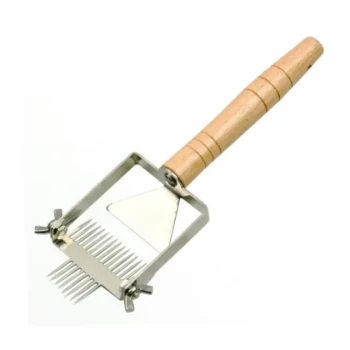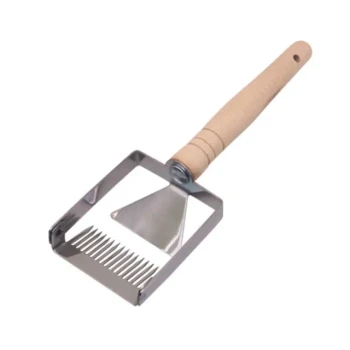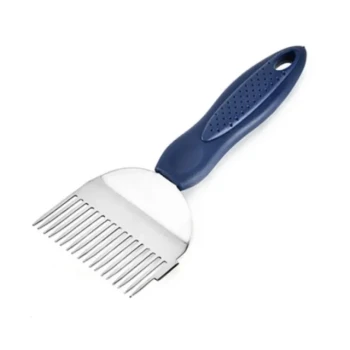To clean raw propolis, you primarily use a simple water-washing method after it has been harvested and frozen. The brittle, frozen propolis is first separated from the collection trap, then agitated in water. This process allows lighter debris like wood splinters to float for skimming while heavier contaminants sink, leaving the purified propolis to be strained and thoroughly dried.
The key to effective propolis cleaning isn't the washing itself, but the harvesting method that precedes it. Using a modern propolis trap minimizes initial contaminants, making the final cleaning and purification steps significantly faster and more efficient.

The Foundation: Harvesting for Purity
Before you can clean propolis, you must harvest it. The method you choose has the single biggest impact on how much cleaning will be required.
When to Harvest
Propolis production in a beehive peaks during late summer and early fall. This is the ideal time to encourage bees to produce a clean supply for harvesting.
Using a Propolis Trap
The most efficient collection method involves a propolis trap, which is typically a flexible plastic mat with small grooves or gaps. Placed on top of the hive frames, it encourages the bees' natural instinct to seal these gaps with propolis. This method yields a much cleaner product than scraping propolis from hive bodies or frames.
The Critical Freeze
Once the trap is filled, it is removed from the hive and placed in a freezer. Freezing the propolis is a crucial step that makes it extremely brittle and easy to handle. Without this step, the sticky, resinous material would be nearly impossible to separate from the trap.
Separating Propolis from the Trap
After at least a few hours in the freezer, the trap can be removed. By twisting or flexing the cold plastic mat, the frozen propolis will crack and break away cleanly, falling off as small, easy-to-handle chunks.
The Cleaning and Purification Process
With the raw propolis collected, the focus shifts to removing any foreign material.
The Initial Water Wash
Place the chunks of frozen propolis into a container of cool water. Agitate or swish the mixture vigorously. The propolis itself is dense and will typically remain suspended or sink.
Lighter debris, such as small pieces of wood or other hive matter, will float to the surface. This can be easily skimmed off with a small strainer. Heavier debris, like dirt, will sink to the bottom.
Straining and Rinsing
After skimming, carefully pour the water and propolis through a strainer. This will capture the cleaned propolis while allowing the dirty water and any sunken debris to be discarded. You can perform a final rinse with clean water at this stage.
The Importance of Thorough Drying
Spread the cleaned propolis on a screen or towel in a single layer. It must be completely dry before storage to prevent mold and degradation. A well-ventilated, low-humidity area away from direct sunlight is ideal. Once dry, the propolis is ready.
Understanding the Trade-offs
While the process is straightforward, the quality of your final product depends on a key decision.
Scraping vs. Traps
The alternative to using a propolis trap is to scrape propolis from various hive components like frames and boxes. While this yields propolis, it is almost always contaminated with paint chips, wood splinters, and other debris that are very difficult to remove.
A propolis trap is a superior method because it isolates the product from these contaminants, drastically reducing the effort needed for cleaning.
The Limit of Water Washing
It is important to understand that washing with water only removes physical impurities. It does not remove the natural beeswax that is mixed in with the propolis resin. For most applications, such as making tinctures, this wax is perfectly acceptable and will be separated during the subsequent alcohol extraction process.
Making the Right Choice for Your Goal
Your approach should align with your intended use for the propolis.
- If your primary focus is maximum purity for tinctures: Always use a propolis trap and freeze it before collection to minimize wood and wax contaminants from the start.
- If your primary focus is simplicity and low investment: While scraping is an option, a reusable plastic propolis mat is the most efficient method, dramatically reducing your cleaning time and yielding a superior product.
By pairing a clean harvesting technique with a methodical cleaning process, you ensure a high-quality product ready for any application.
Summary Table:
| Step | Key Action | Purpose |
|---|---|---|
| 1. Harvest | Use a propolis trap on the hive | Isolate clean propolis, minimizing contaminants like wood and paint |
| 2. Freeze | Place the filled trap in a freezer | Make propolis brittle for easy separation from the trap |
| 3. Separate | Flex or twist the frozen trap | Collect raw propolis in clean chunks |
| 4. Wash | Agitate propolis in cool water | Float lightweight debris for skimming; sink heavy impurities |
| 5. Dry | Spread propolis on a screen in a ventilated area | Prevent mold and ensure stability for storage |
Ready to produce high-quality propolis efficiently? The right equipment makes all the difference. HONESTBEE supplies durable, commercial-grade propolis traps and other essential beekeeping supplies to commercial apiaries and distributors. Our wholesale-focused operations ensure you get reliable gear that simplifies harvesting and maximizes purity.
Contact our team today to discuss your needs and see how our solutions can enhance your propolis yield and quality.
Visual Guide

Related Products
- Stainless Steel Triangle Support Honey Strainer and Filters
- Adjustable Stainless Steel Honey Uncapping Fork with Scraper Beekeeping Tool
- Easy Use Manual Stainless Steel Honey Press for Honey Comb
- Honey Concentrating and Filtering Dehumidifier Machine 2T Capacity for Honey
- Automatic Honey Frame Uncapper Machine for Beekeeping
People Also Ask
- What methods are used for straining honey? Choose the Right Method for Your Scale
- Should honey be filtered or unfiltered? Maximize Health Benefits with Raw Honey
- What is the easiest way to strain honey? A Simple Guide for Hobbyist Beekeepers
- What are the benefits of using a honey filtering machine? Boost Purity, Efficiency & Market Appeal
- What are the benefits of using a honey strainer for beekeepers? Achieve Clean, High-Quality Honey Efficiently



















